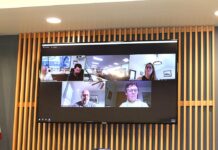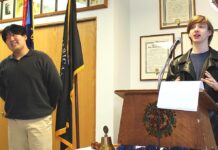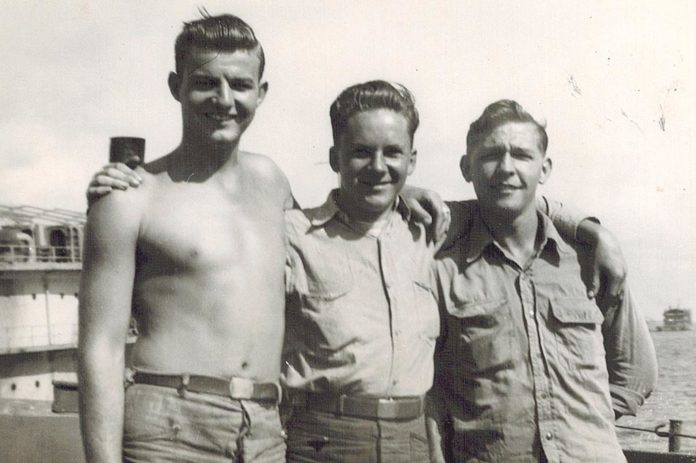
Like many patriotic youths during World War II, Chris Shelvik, born Feb. 25, 1926, signed up for the military, joining the U.S. Navy on Nov. 26, 1943. The Washington native, who dropped out of high school at age 17 to enter military service, wanted to be trained as a motor machinist but instead got assigned to signal school.
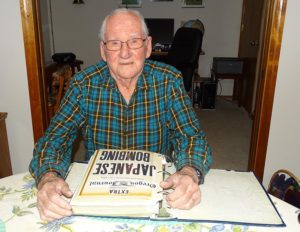
That turned out to be a lucky assignment for him. Navy signalmen communicate using flags and lights, which Shelvik thought sounded boring. But he passed the course with flying colors, and instead of toiling away in hot engine rooms on the ships he served on, he worked up top.
After basic training, Shelvik was sent to Naval Station Treasure Island and assigned to a troop transport ship bound for Milne Bay, New Guinea. “We broke down right away, and half of us were seasick,” Shelvik said. “We went back to port. There were 3,000 of us fellows, and we were kept on board for 10 days, and they wouldn’t turn on water for the showers. It took 18 days to get to New Guinea, and out in the Pacific, there was a heavy rainstorm. All of us took off our clothes and stood on the deck, which was the only ‘shower’ we got in a month. The first night ashore in New Guinea, everyone got a shower.”
In New Guinea, Shelvik got an easy assignment, guarding the toilet paper in the latrines to keep the locals from stealing it.
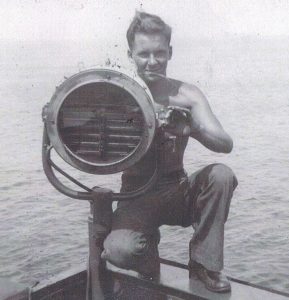
He then was transported to Hollandia, New Guinea, where he was assigned to LCI (R) 337. The earlier version of the Landing Craft Infantry amphibious assault ship featured stairs on the sides for troops to descend, and the later version featured a large ramp that extended out the front of the ship for troops to disembark. LCI-337, whose side stairs had been replaced with mounted rocket launchers, was first sent to the Solomon Islands, with Shelvik one of three signalmen, serving four hours on and eight hours off.
From there, the ship participated in the Battle of Leyte Gulf in the Philippines, where over four days from Oct. 23-26, 1944, the Allies devastated the Japanese Combined Fleet in an air-and-sea battle that led to the U.S. invasion of the Philippines.
“There was lots of activity, and a lot of ships were sunk,” Shelvik said. “We were fired on but never got hit. Four of our ships sank – two destroyers, a destroyer escort and an aircraft carrier with about 900 aboard. There were sharks in the water, and seven of our ships were told to pick up survivors. We picked up 180.”
During his time in active combat, Shelvik said, “I made seven landings during battle before I turned 19 years old and made 11 landings total. We shot almost 500 4.5 rockets per landing.”
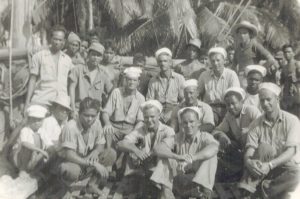
LCI-337 was practicing landings in the Philippines in preparation for the invasion of Japan when the U.S. detonated two nuclear weapons over Hiroshima and Nagasaki on Aug. 6 and 9, 1945, and Japan surrendered Aug. 15.
“It was unbelievable,” Shelvik said. “There were five or six ships making dummy runs toward the beach, and after the news broke, the ships went in all directions. They brought out the beer – there was lots of beer – and I don’t think anyone was sober.”
His ship made other ports before heading toward Okinawa, Japan, when it was hit by a typhoon. After a week at Okinawa, another typhoon hit while LCI-337 was anchored off-shore, and the ship almost made it to shore when it was hit by two barges and sank to the bottom.
“The water was not very deep, but the waves were 35 feet high, and we abandoned ship,” Shelvik said. “They put us in tents, but another typhoon blew all the tents away. After that typhoon, the crew was sent all different places.”
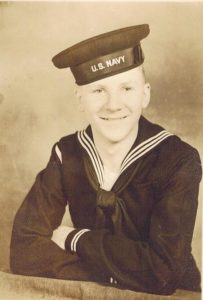
He was assigned to an LST (Landing Ship Tank) and sent to Shanghai, transporting Chinese troops, Japanese prisoners of war and Japanese civilians at different times. Shelvik was discharged at the age of 21 with the rank of Signalman Second Class.
He got his high school diploma and has mostly lived in the Portland area, including the last 22 years in Tigard. He worked at several different jobs including 22 years as a house painter before retiring in 1988.
Shelvik’s first wife died after 47 ½ years of marriage, and he has been with his current partner for 22 years while also staying in touch with his Navy buddies. He has been active in both the USS LCI National Association as well as the Amphibious Forces Memorial Museum, an Oregon non-profit organization that is restoring LCI (L) 713 on Swan Island, which is the last remaining LCI in original war-time configuration.
Shelvik has attended about 15 of the annual national reunions since 1991, and at the second national reunion in 1992, seven of his original 35-man crew were there, which dwindled to five crew members several years ago. “I think I might be the last one left now,” said, Shelvik, who also belongs to the Hillsboro Elks Club and was Exalted Ruler in 1985.



